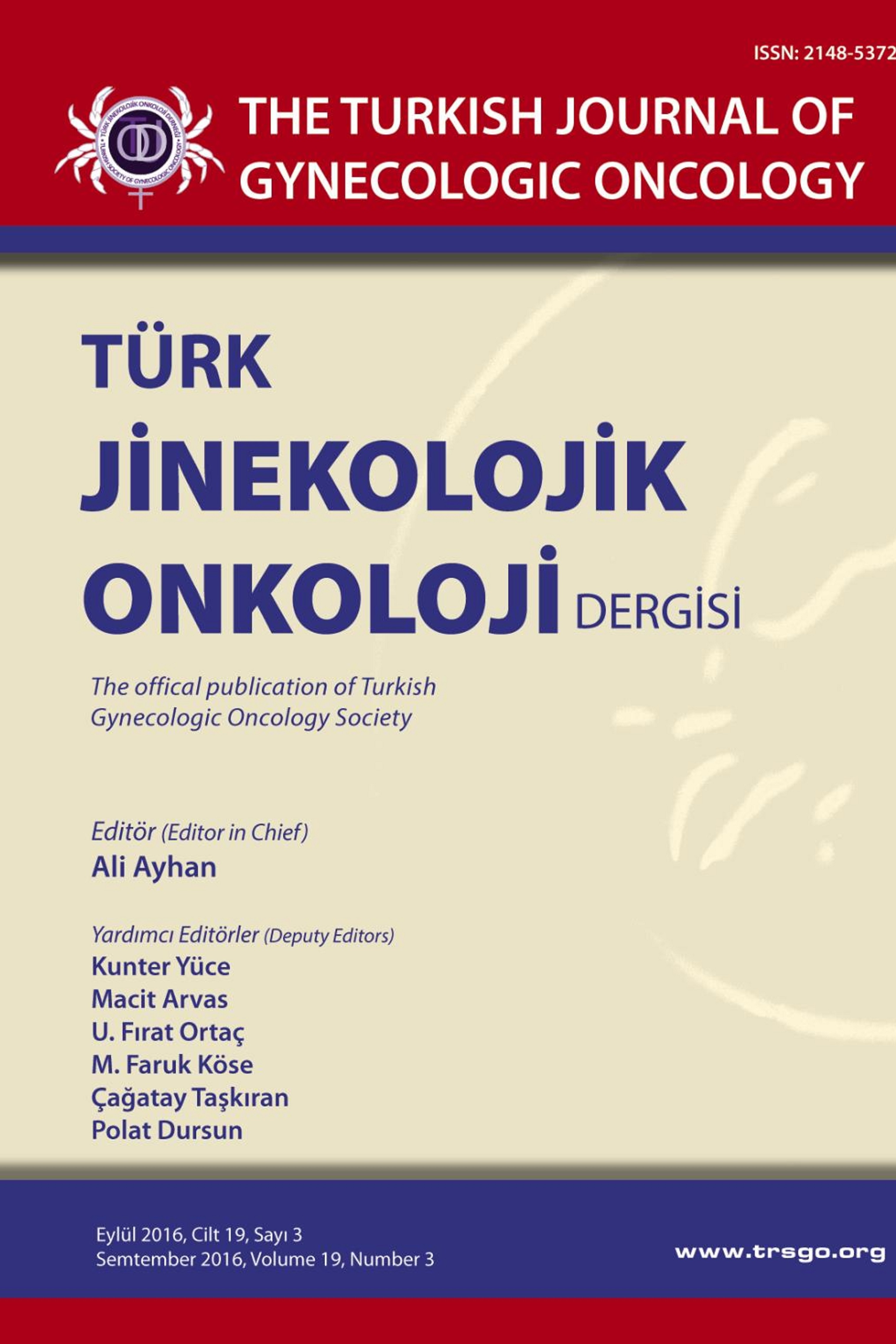HUMAN PAPİLLOMAVİRUS GENOTİPLERİNİN PYROSEQUENCİNG METODU İLE TESPİTİ
HPV, genotip, pyrosequencing, servikal kanser, tarama
DETECTION OF HUMAN PAPILLOMAVIRUS GENOTYPES BY PYROSEQUENCING METHOD
HPV, genotip, pyrosequencing, servikal kanser, tarama,
___
- 1. Walhart T.J. Human Papillomavirus Biology, Pathogenesis, and Potential for Drug Discovery: A Literature Review for HIV Nurse Clinical Scientists. Assoc Nurses AIDS Care. 2015; 26(6):693-702.
- 2. Comparetto C, Borruto F. Cervical cancer screening: A never-ending developing program. World J Clin Cases. 2015;3(7): 614–624.
- 3. Fernandes JV, Fernandes TA. Human Papillomavirus: Biology and Pathogenesis. Human Papillomavirus and Related Diseases – From Bench to Bedside– A Clinical Perspective. In Tech 2012 DOI: 10.5772/2464.
- 4. Egawa N, Egawa K, Griffin H, Doorbar J. Human Papillomaviruses; Epithelial Tropisms, and the Development of Neoplasia. Viruses. 2015;7(7):3863-90.
- 5. Bansal A, Singh MP, Rai B. Human papillomavirus-associated cancers: A growing global problem. Int J Appl Basic Med Res. 2016; 6(2):84-9.
- 6. Lees BF, Erickson BK, Huh WK. Cervical cancer screening: evidence behind the guidelines. Am J Obstet Gynecol. 2016; 214(4):438-43.
- 7. Moreira ED Jr, Block SL, Ferris D, et al. Safety Profile of the 9-Valent HPV Vaccine: A Combined Analysis of 7 Phase III. Clinical Trials. 2016;138(2)..
- 8. Yuce K, Pinar A, Salman MC, ve ark. Detection and genotyping of cervical HPV with simultaneous cervical cytology in Turkish women: a hospital-based study. Arch Gynecol Obstet. 2012; 286(1):203-8.
- 9. Sahiner F, Gümral R, Sener K,ve ark. Investigation of HPV-DNA in cervical smear samples by two different methods: MY09/11 consensus PCR and type-specific real-time PCR. Mikrobiyol Bul. 2012; 46(4):624-36.
- 10. Tezcan S, Ozgur D, Ulger M, ve ark. Human papillomavirus genotype distribution and E6/E7 oncogene expression in Turkish women with cervical cytological findings. Asian Pac J Cancer Prev. 2014; 15(9):3997-4003.
- 11. Fındık D. Türk Dağı H. Arslan U. Fındık Y. Servikal örneklerde human papillomavirus sıklığı ve genotip dağılı- mı Genel Tıp Derg 2012; 22(4):116-20.
- 12. Şahiner F, Kubar A, Gümral R, ve ark. Efficiency of MY09/11 consensus PCR in the detection of multiple HPV infections. Diagn Microbiol Infect Dis. 2014; 80(1):43-9.
- 13. Demir ET, Ceyhan M, Simsek M, ve ark. The prevalence of different HPV types in Turkish women with a normal Pap smear. J Med Virol. 2012; 84(8):1242-7.
- 14. Tüney İ, Altay A, Ergünay K, ve ark. HPV tyes and E6/ E7 mRNA expression in cervical samples from Turkish women with abnormal cytology in Ankara, Turkey. Turk J Med Sci. 2017; 47: 194-200.
- 15. Santos Filho MV, Gurgel AP, Lobo CD, Freitas AC, SilvaNeto JC, Silva LA. Prevalence of human papillomavirus (HPV), distribution of HPV types, and risk factors for infection in HPV-positive women. Genet Mol Res. 2016; 14;15(2).
- 16. Meloni A, Pilia R, Campagna M, et al. Prevalence and molecular epidemiology of human papillomavirus infection in italian women with cervical cytological abnormalities. J Public Health Res. 2014 ;3(1):157.
- 17. Grozdanov P, Zlatkov V, Ganchev G, Karagiosov I, Toncheva D, Galabov AS. HPV prevalence and type distribution in women with normal or abnormal Pap smear in Bulgaria. J Med Virol. 2014; 86(11):1905-10.
- 18. Salcedo M, Pina-Sanchez P, Vallejo-Ruiz V, et al. Human papillomavirus genotypes among females in Mexico a study from the Mexicaninstitute for social security. Asian Pac J Cancer Prev. 2014; 15(23):10061-6.
- 19. Yousefzadeh A, Mostafavizadeh SM, Jarollahi A, et al. Human papillomavirus (HPV) prevalence and types among women attending regular gynecological visit in Tehran. Iran. Clin Lab. 2014; 60(2):267-73.
- 20. Moga MA, Irimie M, Oanta A, Pascu A, Burtea V. Typespecific prevalence of human papillomavirus by cervical cytology among women in Brasov, Romania. Asian Pac J Cancer Prev. 2014; 15(16):6887-92
- 21. Lewis-Bell K, Luciani S, Unger ER, et al. Genital human papillomaviruses among women of reproductive age in Jamaica. Rev Panam Salud Publica. 2013; 33(3):159-65.
- 22. Lindemann ML, Sánchez Calvo JM, Chacón de Antonio J, et al. Prevalence and Distribution of High-Risk Genotypes of HPV in Women with Severe Cervical Lesions in Madrid, Spain: Importance of Detecting Genotype 16 and Other High-Risk Genotypes. Adv Prev Med. 2011;
- 23. De Jonge M, Busecke G, Heinecke A, Bettendorf O. Human papillomavirus genotype distribution in cytologically screened women from northwest Germany. Acta Cytol. 2013; 57(6):591-8.
- 24. Heard I, Tondeur L, Arowas L, Falguières M, Demazoin MC, Favre M. Human papillomavirus types distribution in organised cervical cancer screening in France. PLoS One. 2013 14;8(11).
- 25. Aguilar-Lemarroy A, Vallejo-Ruiz V, Cortés-Gutiérrez EI, et al. Human papillomavirus infections in Mexican women with normal cytology, precancerous lesions, and cervical cancer: type-specific prevalence and HPV coinfections. J Med Virol. 2015; 87(5):871-84.
- ISSN: 2148-5372
- Başlangıç: 2014
- Yayıncı: Türk Jinekolojik Onkoloji Derneği
İLERİ EVRE YÜKSEK GRADE ENDOMETRİUM KANSERLİ HASTALARDA SAĞKALIM SONUÇLARI
Alpaslan KABAN, Samet TOPUZ, Hamdullah SÖZEN, Yavuz SALİHOGLU
GESTASYONEL TROFOBLASTİK HASTALIKLARA GÜNCEL YAKLAŞIM CONTEMPORARY
Kemal GÜNGÖRDÜK, Ceysu KOCAHAKİMOĞLU, Muzaffer SANCI, Özalp Sabit SİNAN, Varol GÜLSEREN, Dilek KARTAL
HUMAN PAPİLLOMAVİRUS GENOTİPLERİNİN PYROSEQUENCİNG METODU İLE TESPİTİ
Serap ÖZEN, Mehmet ÇİMENTEPE, Buket ŞEFLEK, Mehmet Ali VARDAR, Derya GÜMÜRDÜLÜ, Fügen YARKIN
SERVİKS KANSERİ YA DA SERVİKAL İNTRAEPİTHELİAL NEOPLAZİ SAPTANAN HASTALARIN HPV TEST SONUÇLARI
Fatma SERT, Senem ALANYALI, Arif Bülent ARAS, Zeynep ÖZSARAN
